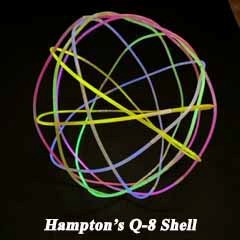THE HAMPTON BREAKTHROUGH (July 25, 2025)
Previously Stephen James Taylor and Jesús Treviño produced three videos which encapsulated our understanding of the Gurule system of natural order: An Invitation to Gurule, Gurule Shells A System of Natural Order and Beyond a Quantum Metaphor (https://gurule-system.com/) In the last video, the authors speculated that they had reached the extent of their ability to plumb the mysteries of the Gurule system because they lacked advanced training in mathematics and quantum physics. The door was left open for future investigators to explore the legacy left by Benjamin Gurule after more than fifty years of a life pursuing his unique vision. The key was finding someone with the mathematical background, knowledge of physics and passion to continue the quest.
On August 19th, 2022 Stephen James Taylor visited Virginia Polytechnic Institute to present a performance of his microtonal surround sound composition “Music from the Other Wakanda.” During the course of his visit Taylor introduced the Gurule Shell system to a physics student, Hampton Smith, who expressed great interest in finding out more about the Gurule system. Beginning with a Zoom conference call on August 31, 2022, Hampton Smith took the lead in trying to ferret out the Gurule system and determine how it applied to contemporary mathematics. By the second Zoom conference call, Hampton had determined that the Gurule system was related to mathematical knot theory. Subsequently, Hampton was able to ascertain that the seven shells described in the Gurule system (Q1-Q7) could be expressed in Knot Theory as a Braid Word, an algorithmic equation which describes a specific knot braid, such as a Hopf link ![]() or a Borromean link
or a Borromean link
![]()
Hampton set out to calculate a braid word equation that might describe the knots evident in the Gurule shells. He was searching for a braid generator, an equation key that could be applied to all of the Gurule shells. The burning question was whether Gurule’s premise that seven was the upper limit for the number of possible shells (braids) in the system was accurate or not.
In subsequent zoom meetings, Hampton revealed he had been successful in configuring a Braid Word equation as a generator for all the Gurule shells: By applying the Braid Word generator to the Gurule shells he concluded that an 8th level was entirely possible. In short order, he devised an equation for the Q-8 braid:

He then wove a Q-8 structure proving that there was no upper limit to Gurule shells:

This was a conceptual break through in understanding the Gurule system.
Hampton concluded that the number of shells possible in the Gurule universe is limited only by the physical difficulty in weaving the complex strands of levels higher than eight. The assembly of a Q-8, and the discovery that there were no limits to shells in the Gurule universe, signaled that the rules Gurule had developed for his seven shell system applied to all braided knots.
But vexing questions remained.
The Gurule system posits that the seven shells (Q2-Q7…omittingQ1 which has no relationship to another ring)) have the property of chirality and of being transformed through “the polyhedral shift” into polyhedra. The bands (or braids) in the system can be subdivided, ad infinitum, creating an infinite number of “harmonics” for each band, suggesting a complexity not evident in single strand braids. None of these properties, however, are addressed by the Braid Word equation formulated by Hampton in creating his Q-8 structure. It raised the question: what is the relationship of the Word Braid equation for Q2 through Q8 to chirality and polyhedral shift and to braid harmonics?
Ben Gurule always felt that his system could provide insight into the classical model for quantum physics. That is, that it could give insight into scientifically testable proofs that would expand our knowledge of quantum physics and have applications in the real world such as has happened with the large Hadron Collider. He believed the underlying principles of his system had to do with molecular structure and particle theory. But since the Word Braid is essentially a mathematical equation, does it, in fact, have any relevance to actual scientifically testable and verifiable applications in nature?
Hampton’s Word Braid breakthrough certainly expands our knowledge of the Gurule system but it is silent about any applications to any field other than Knot theory or Group theory. Hampton’s mentor, Dr. Tatsu Takeuchi, who has viewed the Gurule videos, does not believe Gurule’s system is tied to molecular orbital structure but rather is tied to mathematical group theory.
But is this really so?
One of the criticisms of Gurule was that his approach was linear and reflected old notions of the quantum model. Hampton stressed that much of the current theorizing of the quantum models envisions “probability clouds” rather than definite measurable action of particles. The Gurule system does not rule out viewing quantum models in this way.
Before we completely rule out the applicability of the Gurule system to modern models of quantum physics, isn’t it prudent to ask: is anyone working in these fields who might find affinity with the underlying premises of the Gurule system and its conceptual infrastructure? It makes sense to envision any further pursuit of the enigmatic Gurule system as having to do with areas of knowledge still being debated and shaped such as with Relativistic Quantum Gravity and Quantum Field Theory.
The door to future insights into Gurule is still open for any takers in these fields.